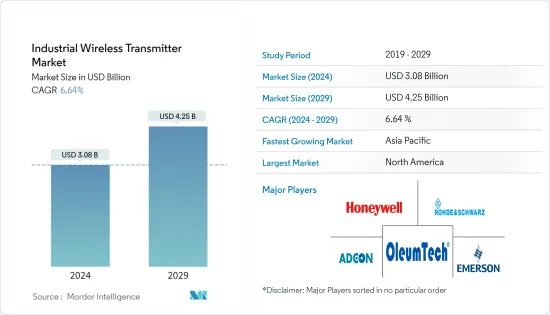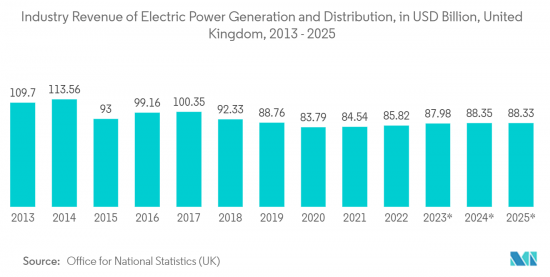 |
市場調查報告書
商品編碼
1403842
工業無線發射器:市場佔有率分析、產業趨勢與統計、2024年至2029年成長預測Industrial Wireless Transmitter - Market Share Analysis, Industry Trends & Statistics, Growth Forecasts 2024 - 2029 |
||||||
※ 本網頁內容可能與最新版本有所差異。詳細情況請與我們聯繫。
工業無線發射器市場規模預計到2024年為30.8億美元,預計到2029年將達到42.5億美元,在預測期內(2024-2029年)複合年成長率為6.64%。

主要亮點
- 隨著全球對抗 COVID-19 大流行的技術創新加速,工業無線發射器網路經歷了顯著成長。電子技術的進步是由對更小型設備的需求推動的,從更快的熱感成像和現場護理測試到基於微流控的聚合酶鏈反應(PCR) 工具和SARS-CoV-2 檢測技術,有許多不同的技術。
- 工業無線溫度變送器和感測器市場已採用物聯網 (IoT) 連接來加快 COVID-19篩檢速度。多家公司合作開發了一系列用於人體溫度監測的穿戴式裝置。這款穿戴式裝置的發送器向第一線醫護人員提供即時資料,使他們能夠快速篩檢體溫過高的人,體溫過高是 COVID-19 最常見的症狀之一。此外,上海公共衛生臨床中心 (SPHCC) 正在使用加州互聯連線健診新興企業VivaLNK 的連續無線溫度發射器和感測器網路來監測 COVID-19 患者和看護者暴露於病毒的風險。
- 自動化和機器人產業的成長,資產監控、安全和運輸領域對無線發射器網路的需求不斷增加,以及通訊技術進步帶來的可靠性提高,是推動工業無線發射器市場的主導因素。
- 這些發射器主要在工廠中用於生產流程的資料監控。它也應用於其他行業,如國防、建築自動化、物料搬運以及食品和飲料。
- 隨著政府對發射機安全使用的法規不斷加強,對無線發射機的需求也不斷增加。例如,這是一個具有極高壓力和溫度等惡劣環境條件的領域。工業無線發射器可以輕鬆地在安全距離內連續控制和監控您的設施。它對於從難以存取的位置檢索資料也很有用。
- 此外,智慧家庭、智慧建築、智慧城市和智慧工廠的發展利用小尺寸、低功耗、高精度和無線技術來控制智慧家庭中的環境參數(濕度、壓力、空氣品質等) . - 需要使用工業無線發射器,因為它們能夠被監控。
- 隨著汽車產業努力遵守全球環境法規,提高效率並更好地控制引擎系統比以往任何時候都更加重要。此類應用需要高效的發送器網路,透過藍牙技術準確監控狀況,而無電池射頻識別 (RFID) 技術則透過專注於車內的非關鍵系統來提高效率。
- 2022 年 11 月,OleumTech 宣布推出兩款新型硫化氫 (H2S) 氣體偵測發射器。一個用於 OTC 無線感測器網路平台,另一個用於 H 系列硬連線儀器產品線。新型 H2S 發射器旨在持續監測空氣質量,並在 H2S 水平超過用戶配置的設定值時發出警報。
- 此外,2022年6月,Optex推出了採用LTE-Cat M1*1作為通訊標準的多轉換器OWU-300M系列物聯網無線單元。 Optex 的物聯網無線單元只需連接現有的發射器、感測器和交換器即可實現物聯網,從而可以輕鬆地從遠端位置監控感測器資料和運作狀態。
工業無線發射器市場趨勢
能源和電力預計將佔據很大佔有率
- 工業無線發射器的主要最終用戶群體是能源和電力部門。由於無線發射器網路等無線解決方案的採用率很高,並且即使在困難的地點也易於安裝,無線發射器在業界已廣泛應用。
- 與有線發射器不同,有線發射器不需要將訊號佈線回相應的無線閘道器。近年來,電池供電的發射器模組不再需要電源接線。由於其彈性,現代無線發射器可以放置在任何地方來監控幾乎任何東西。
- 在電力和能源領域,無線發射器現在可以安裝在祛水器、熱交換器、泵浦、壓縮機、洩壓閥以及許多其他以前使用有線技術難以監控且維護成本昂貴的設備上。
- 全球發電活動的增加預計將推動所研究市場的成長。例如,根據電力工程師有限責任公司的數據,經過幾年的穩定成長,巴西的發電量在 2022 年達到了 677兆瓦時以上。水力發電是巴西最重要的發電來源,預計到2022年將佔全國發電量的60%以上。 2021年巴西發電量為656.11兆瓦時。
- 供應商正在擴大其在市場上的製造設施,為所研究的細分市場創造更多商機。根據巴西電力監管局的數據,巴西發電裝置容量從2021年的181.61吉瓦增加到2022年的189.13吉瓦。

北美佔據主要市場佔有率
- 無線發射器的需求主要是由北美的高製造業活動所推動的,佔該地區國內生產總值(GDP) 的 23% 以上。該地區為幾乎所有最終用戶垂直市場提供了清晰的前景。預計該地區工業無線發射器的主要需求來源是能源、電力和工業自動化。
- 拜登政府為重振遭受疫情打擊的美國經濟而推出的投資,使基礎設施和電子產業以及小型企業的成長成為主要受益者。基礎設施和電子產業是包括無線發送器在內的工業控制系統硬體產品的大量用戶,預計將產生直接的正面影響。
- 由於自動化、機器人、物聯網和其他連網型解決方案在工業領域的使用,預計該地區將在整個預測期內佔據重要的市場佔有率。
- 頁岩氣探勘和精製活動的激增預計將對無線發送器市場產生重大影響。無線發射器在頁岩氣產業中用於追蹤石油和天然氣流量、油輪液位和石油鑽井過程中的壓力。因此,無線電發送器對於控制資源的移動和儲存至關重要。隨著北美頁岩氣開採的發展,預計該行業將更頻繁地使用無線發射器。
- 由於這些工具能夠讓經理和監督從任何地方評估工人和設備的性能,製造設施中使用的智慧設備的數量在全部區域不斷增加。由於這些改進,系統需要整合無線電發送器。
- 隨著智慧型手機在美國越來越普及,對工業無線發射器的需求預計也會同時增加。根據美國人口普查局和消費者技術協會的數據,美國智慧型手機銷售額預計將從 2021 年的 730 億美元增加到 2022 年的 747 億美元。隨著智慧型手機在市場中的普及不斷提高,對無線發射器的需求預計也會以同樣的速度成長。
工業無線發射器產業概況
工業無線發射器市場呈現分散化、競爭激烈的特點,許多主要企業爭奪市場佔有率。其中許多公司正在透過贏得合約和推出創新產品和服務來擴大其市場足跡。此外,該領域的公司正在積極與專門從事工業無線發射器技術的新興企業合作,以增強其產品能力。
2023 年 3 月,Honeywell國際公司推出了 Versatilis 變送器,專為對泵浦、馬達、壓縮機、風扇、鼓風機和變速箱等旋轉設備進行狀態監控而設計。HoneywellVersatilis 變送器旨在提供旋轉設備的精確測量,提供寶貴的見解,從而提高各行業的安全性、可用性和可靠性。
2022 年 5 月,Monnit 推出本質安全型 ALTA-ISX遠距無線發射器。這項進步體現了 Monnit 在充滿挑戰的工業環境中促進安全的承諾。
其他福利:
- Excel 格式的市場預測 (ME) 表
- 3 個月分析師支持
目錄
第1章簡介
- 研究假設和市場定義
- 調查範圍
第2章調查方法
第3章執行摘要
第4章市場洞察
- 市場概況
- 技術概述
- 產業吸引力-波特五力分析
- 供應商的議價能力
- 買方議價能力
- 新進入者的威脅
- 替代品的威脅
- 競爭公司之間敵對關係的強度
- 評估主要宏觀經濟趨勢的市場影響
第5章市場動態
- 市場促進因素
- 擴大物聯網在工業領域的應用
- 工業控制系統的普及
- 市場抑制因素
- 無線通訊安全問題
第6章市場區隔
- 類型
- 一般用途
- 液位傳送器
- 壓力變送器
- 溫度變送器
- 流量傳送器
- 其他類型
- 最終用戶
- 能源和電力
- 食品和農業
- 工業自動化
- 水和污水處理
- 其他最終用戶
- 地區
- 北美洲
- 歐洲
- 亞太地區
- 拉丁美洲
- 中東/非洲
第7章競爭資訊
- 公司簡介
- Emerson Electric Company
- Honeywell International Inc.
- Rohde & Schwarz GmbH & Co. KG
- Adcon Telemetry GmbH
- OleumTech Corporation
- Inovonics Corporation
- Cooper Industries Inc.(Eaton Corporation PLC)
- Phoenix Contact
- Ascom Wireless Solutions AG
- Siemens Corporation
- Schneider Electric Corporation
- Keri Systems Inc.
第8章投資分析
第9章 市場機會及未來趨勢

The Industrial Wireless Transmitter Market size is estimated at USD 3.08 billion in 2024, and is expected to reach USD 4.25 billion by 2029, growing at a CAGR of 6.64% during the forecast period (2024-2029).
Key Highlights
- Industrial wireless transmitters network has viewed immense growth as technology companies globally accelerated innovation in the fight against the COVID-19 pandemic. The need for tiny devices is behind advances in electronics, thus, ranging from thermal imaging and faster point-of-care testing to microfluidics-based polymerase chain reaction (PCR) tools and techniques to detect SARS-CoV-2.
- Industrial wireless temperature transmitters and sensors in the market employed Internet of Things (IoT) connectivity to speed up COVID-19 screening. Multiple companies joined forces to develop a series of human body temperature monitoring wearable devices. The wearable devices' transmitters offered real-time data to frontline healthcare workers and let them quickly screen individuals with a high temperature, one of the most common symptoms of COVID-19. Moreover, Shanghai Public Health Clinical Center (SPHCC) used California-based connected health startup VivaLNK's continuous wireless temperature transmitters and sensors network to monitor COVID-19 patients, which decreased the risks of caregivers being exposed to the virus.
- The growing automation and robotics industry, growing demand for a wireless transmitter network in asset monitoring, security, and transportation, and improved reliability with communication technology advancements are the influential factors driving the industrial wireless transmitter market.
- These transmitters are primarily used in factory settings for data monitoring of production flow. These also find applications in defense, building automation, and other industries, like materials handling and food and beverage.
- Due to the increased government regulation for the increased use of transmitters for safety, the demand for wireless transmitters is growing. For example, the areas with challenging environmental conditions, such as extreme high pressure, high temperature, etc. With the help of industrial wireless transmitters, it becomes easy to control and monitor the facility from a safe distance continually. They help to acquire the data from locations that are difficult to access.
- Further, transforming the growth of smart homes and buildings, smart cities, and smart factories demand the use of industrial wireless transmitters, owing to the small form factor, low power consumption, high precision, and ability to control and monitor ambient parameters (such as humidity, pressure, and air quality) in smart homes with the help of wireless technologies.
- As the automotive industry strives to comply with worldwide environmental regulations, the efforts to boost efficiency and achieve better control of engine systems are more crucial than ever. These applications demand efficient wireless transmitter networks to accurately monitor conditions through Bluetooth technology, and battery-free radio frequency identification (RFID) technology enhances efficiency by concentrating on non-critical systems inside vehicles.
- In November 2022, OleumTech introduced two new Hydrogen Sulfide (H2S) Gas Detection Transmitters: one to its OTC Wireless Sensor Network platform and the other to its H Series hardwired process instrumentation product line. The new H2S Transmitters were designed to continuously monitor air quality and generate alarms when H2S levels exceed user-configured setpoints.
- Further, in June 2022, Optex Co., Ltd. launched the Multi-Converter OWU-300M Series IoT wireless units, which use LTE-Cat M1*1 as their communication standard. Optex's IoT wireless units make IoT possible by simply connecting existing transmitters, sensors, and switches, allowing for simple monitoring of sensor data and operational status from remote locations.
Industrial Wireless Transmitter Market Trends
Energy and Power is Expected to Hold a Significant Share
- The energy and electricity sector is the primary end-user group for industrial wireless transmitters. Due to the high deployment rate of wireless solutions, such as wireless transmitters networks, etc., and their ease of installation even in difficult-to-reach locations, wireless transmitters are widely used in the industry.
- Unlike wired transmitters, wired transmitters do not require any signal wiring to return to a corresponding wireless gateway. The use of battery-powered transmitter modules eliminated the requirement for power wiring in recent years. Modern wireless transmitters can be deployed anywhere to monitor almost anything because of their flexibility.
- In the case of the power and energy sector, numerous pieces of equipment, including steam traps, heat exchangers, pumps, compressors, and pressure relief valves, which were previously difficult to monitor and frequently expensive to maintain using wired technology, can now be equipped with wireless transmitters.
- The increasing power generation activities globally are anticipated to rev the studied market's growth. For instance, according to Electric Power Engineers, LLC, the electricity generation in Brazil amounted to more than 677 terawatt-hours in 2022 after growing steadily for a few years. Hydropower is observed to be the most crucial electricity generation source in Brazil, accounting for more than 60 percent of the country's output in 2022. In 2021, the electricity generation in Brazil amounted to 656.11 terawatt-hours.
- Vendors are expanding their manufacturing facility in the market, further creating opportunities for the studied segment. According to the Brazilian Electricity Regulatory Agency, the installed capacity for electricity generation in Brazil increased from 181.61 gigawatts in 2021 to 189.13 gigawatts in 2022.

North America Holds a Significant Market Share
- Demand for wireless transmitters is mainly driven by North America's high manufacturing activity, which contributes more than 23 percent of the region's gross domestic product (GDP). Almost all end-user verticals contain a clear prognosis for the area. The region's primary sources of demand for industrial-grade wireless transmitters are expected to be energy, power, and industrial automation.
- With investment roll-outs by the Biden government to revive the pandemic-hit US economy, infrastructure, and the electronics industry are marked as the primary beneficiaries alongside the growth of small and medium-sized enterprises. The infrastructure and electronics industry are heavy users of industrial control systems' hardware products, including wireless transmitters, and are expected to have a direct positive effect.
- Due to the use of automation, robots, the Internet of Things, and other connected solutions in the industrial sector, the region is anticipated to include a significant market share throughout the projected period.
- A surge in shale gas exploration and refining activities is predicted to impact the wireless transmitter market significantly. Wireless transmitters are used in the shale gas industry to track oil and gas flow, oil tanker levels, and pressure during oil extraction. As a result, they are essential in controlling resource movement and storage. As shale gas extraction in North America receives more attention, this industry is projected to use wireless transmitters more frequently.
- The number of smart devices used in manufacturing facilities expanded across the region due to these tools' ability to let managers and supervisors assess the performance of workers and equipment from any location. As a result of these modifications, the system now requires the integration of wireless transmitters.
- With the increasing adoption of smartphone devices in the US, the demand for industrial wireless transmitters is expected to increase simultaneously in the market. As per the US Census Bureau and Consumer Technology Association, smartphone sales in the US are expected to rise to USD 74.7 billion in 2022 compared to USD 73 billion in 2021. With the rising adoption of smartphones in the market, the demand for wireless transmitters is also expected to grow at the same speed.
Industrial Wireless Transmitter Industry Overview
The industrial wireless transmitter market is marked by fragmentation and intense competition, featuring numerous prominent players vying for market share. Many of these companies are expanding their market footprint through the acquisition of contracts and the introduction of innovative products and services. Moreover, businesses operating within this sector are proactively engaging with startups specializing in industrial wireless transmitter technology to enhance their product capabilities.
In March 2023, Honeywell International Inc. introduced its Versatilis Transmitters, designed for the condition-based monitoring of rotating equipment such as pumps, motors, compressors, fans, blowers, and gearboxes. Honeywell's Versatilis Transmitters are engineered to provide precise measurements for rotating equipment, delivering valuable insights that can enhance safety, availability, and reliability across various industries.
In May 2022, Monnit unveiled its intrinsically safe ALTA-ISX Long-Range Wireless transmitters, specifically tailored to safeguard workers and facilities operating in industrial environments with explosive atmospheres. This advancement demonstrates Monnit's commitment to promoting safety in challenging industrial settings.
Additional Benefits:
- The market estimate (ME) sheet in Excel format
- 3 months of analyst support
TABLE OF CONTENTS
1 INTRODUCTION
- 1.1 Study Assumptions and Market Definition
- 1.2 Scope of the Study
2 RESEARCH METHODOLOGY
3 EXECUTIVE SUMMARY
4 MARKET INSIGHTS
- 4.1 Market Overview
- 4.2 Technology Overview
- 4.3 Industry Attractiveness - Porter's Five Forces Analysis
- 4.3.1 Bargaining Power of Suppliers
- 4.3.2 Bargaining Power of Buyers
- 4.3.3 Threat of New Entrants
- 4.3.4 Threat of Substitute Products
- 4.3.5 Intensity of Competitive Rivalry
- 4.4 Assessment of Impact of Key Macroeconomic Trends on the Market
5 MARKET DYNAMICS
- 5.1 Market Drivers
- 5.1.1 Growing Adoption of IoT in Industrial Space
- 5.1.2 Proliferation of Industrial Control Systems
- 5.2 Market Restraints
- 5.2.1 Security Challenges of Wireless Communication
6 MARKET SEGMENTATION
- 6.1 Type
- 6.1.1 General Purpose
- 6.1.2 Level Transmitters
- 6.1.3 Pressure Transmitters
- 6.1.4 Temperature Transmitters
- 6.1.5 Flow Transmitters
- 6.1.6 Other Types
- 6.2 End User
- 6.2.1 Energy and Power
- 6.2.2 Food and Agriculture
- 6.2.3 Industrial Automation
- 6.2.4 Water and waste water Treatment
- 6.2.5 Other End-users
- 6.3 Geography
- 6.3.1 North America
- 6.3.2 Europe
- 6.3.3 Asia Pacific
- 6.3.4 Latin America
- 6.3.5 Middle East and Africa
7 COMPETITIVE INTELLIGENCE
- 7.1 Company Profiles
- 7.1.1 Emerson Electric Company
- 7.1.2 Honeywell International Inc.
- 7.1.3 Rohde & Schwarz GmbH & Co. KG
- 7.1.4 Adcon Telemetry GmbH
- 7.1.5 OleumTech Corporation
- 7.1.6 Inovonics Corporation
- 7.1.7 Cooper Industries Inc. (Eaton Corporation PLC)
- 7.1.8 Phoenix Contact
- 7.1.9 Ascom Wireless Solutions AG
- 7.1.10 Siemens Corporation
- 7.1.11 Schneider Electric Corporation
- 7.1.12 Keri Systems Inc.










